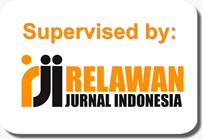MODEL KARAKTERISTIK DAN PERANAN PEKERJA INFORMAL DI KOTA PADANG
Abstract
Keywords : informal workers, business types, roles, education, prospects
Full Text:
PDFReferences
BAPPENAS, 2009.Peran Sektor Informal Sebagai Katup Pengaman Masalah Ketenagakerjaan. Kajian Evaluasi Pembangunan Sektoral. Kedeputian Evaluasi KinerjaPembangunan.
Harahap, Erni Febrina, 1993. Evaluasi Perbecakan Sebagai Salah Satu Sektor Informal Dalam Menyerap Tenaga Kerja di Kotamadya Pematangsiantar. Skripsi, Fakultas Ekonomi, Universitas Sumatera Utara, Medan.
Kasali, Rhenald, 2010, Sektor Informal Jadi Kekuatan Ekonomi. Jakarta: http:/yea-indonesia.com
Munkner, Hans and Thomas Walter, (2001).Sektor Informal Sumber Pendapatan Bagi Kaum Miskin dalam Menggempur Akar-Akar Kemisikinan (Izzedin Bakhit, dkk), Attacking the Roots of Poverty, Jakarta : Yakoma-PDI
Rachbini, Didik J, 2010. Ekonomi Informal di Tengah Kegagalan Negara. Jakarta: http:/www.unisosdem.org.download
Sekaran, U (2003), Research Methods for Business, 4nd Edition, John Wiley & Sons, New York.(Terjemahan, Penerbit Salemba Empat, 2011).
Sinaga, Anggiat, 2013. Analisis Tenaga Kerja Sektor Informal Sebagai Katup Pengaman Masalah Tenaga Kerja di Kota Medan.QE Journal Vol. 02- No. 01
Suradi, 2011.Peranan Sektor Informal Dalam Penanggulangan Kemiskinan.Informasi, Vol. 16 No. 03 Tahun 2011
S. V.Sthuraman,1997, Urban Poverty and the Informal Sector: A Critical Assessment of Current Strategies. (Geneva, International Labour Organization).
Todaro, Michael P, 2000. Economic Development.Seventh Edition. Pearson Education Limited.
Uppal, J. S, 1988.Informal Sector in Jakarta.The Asean Economic Review, Indian Institute of Economics, Vol. XXX,No. 2, pp.230-245.
Wiebe, Frank, 1996. Income Insecurity and Underemployment in Indonesia’s Informal Sector. Policy Research,Working Paper No. 1639.Washington DC, World Bank East Asia and Pacific Country Department III, Indonesia Policy and Operations Division, pp. 2 – 3.
Winarso, Haryo, dan Gede Budi, 2013. Sektor Informal yang Terorganisasi: Menata Kota untuk Sektor Informal.Kelompok Keahlian Pernencanaa dan Perancangan Kota, Sekolah Arsitektur, Perencanaan dan Pengembangan Kebijakan, Institut Teknologi Bandung
DOI: https://doi.org/10.31846/jae.v4i3.161
Refbacks
- There are currently no refbacks.

This work is licensed under a Creative Commons Attribution-NonCommercial-NoDerivatives 4.0 International License.
e-Jurnal Apresiasi Ekonnomi Indexed by:












